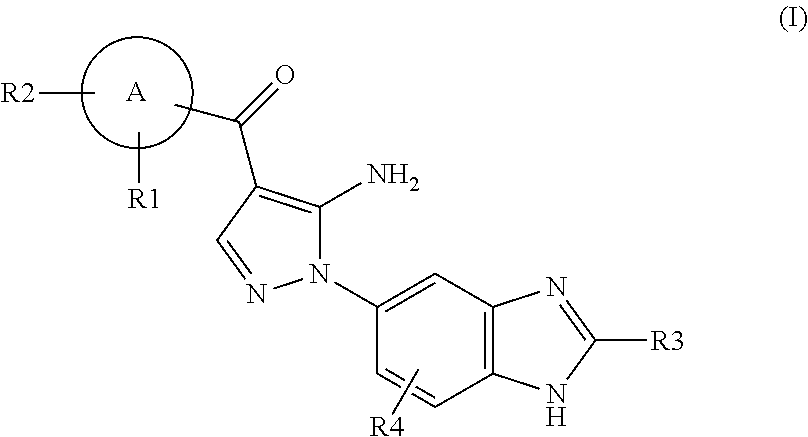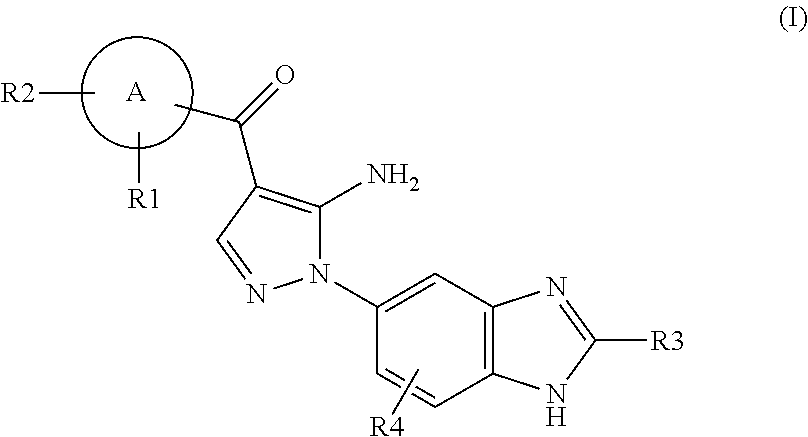Aminopyrazole Derivative
a technology of aminopyrazole and derivatives, which is applied in the direction of heterocyclic compound active ingredients, biocide, drug compositions, etc., can solve the problems that molecular-targeted agents cannot exert efficacy against cancer, and no established therapeutic method is effective against such cancers, and achieves the effect of inhibiting the fibroblast growth factor receptor (fgfr) family kinases and low molecular weigh
- Summary
- Abstract
- Description
- Claims
- Application Information
AI Technical Summary
Benefits of technology
Problems solved by technology
Method used
Image
Examples
example 1
Synthesis of [5-amino-1-(2-methyl-1H-benzimidazol-5-yl)-1H-pyrazol-4-yl]-(1H-indol-2-yl)-methanone
[0957]
[0958]An aqueous solution (1.67 ml) of 4 M sodium hydroxide was added to an ethanol solution (17 ml) of [5-amino-1-(2-methyl-1H-benzimidazol-5-yl)-1H-pyrazol-4-yl]-(1-benzenesulfonyl-1H-indol-2-yl)methanone (87 mg). The resulting mixture was stirred at room temperature for 2 hours. The reaction mixture was poured into water. The resulting solid was collected by filtration, washed with water, and dried to give [5-amino-1-(2-methyl-1H-benzimidazol-5-yl)-1H-pyrazol-4-yl]-(1H-indol-2-yl)methanone (40 mg, 63%).
[0959]1H-NMR (DMSO-D6) δ: 12.47 (1H, s), 11.70 (1H, s), 8.32 (1H, s), 7.70 (1H, d, J=8.0 Hz), 7.66-7.55 (2H, m), 7.50-7.45 (2H, m), 7.31-7.23 (2H, m), 7.10-7.06 (1H, m), 7.01 (2H, brs), 2.53 (3H, s)
[0960]ESI (LC-MS positive mode) m / z 357 [(M+H)+]
example 1a
Synthesis of [5-amino-1-(2-methyl-3H-benzimidazol-5-yl)-1H-pyrazol-4-yl]-(1H-indol-2-yl)-methanone L-malate
[0961]
[0962]Predetermined amounts of L-malic acid (68 g, 0.507 mol) and [5-amino-1-(2-methyl-3H-benzimidazol-5-yl)-1H-pyrazol-4-yl]-(1H-indol-2-yl)-methanone hydrate (190 g, 0.507 mol) were dissolved in dimethyl sulfoxide (0.418 l, 2.2 v / w) and acetone (0.418 l, 2.2 v / w). Then, the resulting solution was filtered using a Kiriyama rohto (No. 4 paper filter), and placed into a 10-1 separable flask with a jacket. The reaction solution was heated at 50° C. for dissolution.
[0963]A predetermined amount of L-malic acid (544.4 g, 4.06 mol) was dissolved in acetone (1.25 l, 6.6 v / w) and acetic acid (0.418 l, 2.2 v / w). Then, the resulting solution was filtered using a Kiriyama rohto (No. 4 paper filter), and placed into a 10-1 separable flask with a jacket while keeping the inner temperature at 45° C. or higher. The seed crystal (0.95 g, 0.5%) was suspended in acetone (7.5 ml), and then ...
example 1b
Synthesis of [5-amino-1-(2-methyl-1H-benzimidazol-5-yl)-1H-pyrazol-4-yl]-(1H-indol-2-yl)-methanone hydrochloride
[0969]
[0970][5-Amino-1-(2-methyl-1H-benzimidazol-5-yl)-1H-pyrazol-4-yl]-(1H-indol-2-yl)-methanone (194 mg) was dissolved in dimethylformamide (1.94 ml). An aqueous solution of 2 M hydrochloric acid (300 μl) was divided into five portions and separately added dropwise thereto at 25° C. 2-Propanol (4 ml) was divided into three portions and separately added to the reaction solution at five-minute intervals. The resulting precipitate was collected by filtration, and washed with 2-propanol (1 ml). Then, the powder was dried under reduced pressure at 40° C. This yielded an opalescent powder (188 mg, 88%).
[0971]11.72 (1H, s), 8.39 (1H, s), 7.96 (1H, d, J=2.1 Hz), 7.92 (1H, d, J=8.7 Hz), 7.71 (1H, t, J=2.1 Hz), 7.68 (1H, t, J=2.1 Hz), 7.51 (1H, s), 7.48 (1H, d, J=2.1 Hz), 7.28 (1H, d, J=7.6 Hz), 7.23 (3H, s), 7.09 (1H, t, J=7.6 Hz), 2.82 (3H, s).
[0972]ESI (LC-MS positive mode) m / z...
PUM
| Property | Measurement | Unit |
|---|---|---|
| temperature | aaaaa | aaaaa |
| temperature | aaaaa | aaaaa |
| temperature | aaaaa | aaaaa |
Abstract
Description
Claims
Application Information
 Login to View More
Login to View More - R&D
- Intellectual Property
- Life Sciences
- Materials
- Tech Scout
- Unparalleled Data Quality
- Higher Quality Content
- 60% Fewer Hallucinations
Browse by: Latest US Patents, China's latest patents, Technical Efficacy Thesaurus, Application Domain, Technology Topic, Popular Technical Reports.
© 2025 PatSnap. All rights reserved.Legal|Privacy policy|Modern Slavery Act Transparency Statement|Sitemap|About US| Contact US: help@patsnap.com



